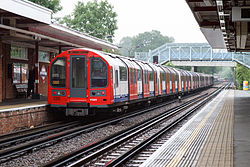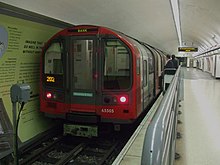London Underground 1992 Stock: Difference between revisions
captions won't display unless the proper parameter is used |
→Announcer system: Minor edit |
||
| Line 48: | Line 48: | ||
==Announcer system== |
==Announcer system== |
||
The Central Line is fitted with an automated voice announcer voiced by [[Emma Clarke]] (originally Janet Mayo). This announcer is colloquially known as |
The Central Line is fitted with an automated voice announcer voiced by [[Emma Clarke]] (originally Janet Mayo). This announcer is colloquially known as "Sonia", derived from the phrase "Get'''s on your''' nerves".<ref> {{cite web |url=http://www.bbc.co.uk/programmes/b01cmsfd |title="The Tube" |author="BBC" |date= |work= |publisher=}}</ref> |
||
''On a Central line train to Ealing Broadway'': |
''On a Central line train to Ealing Broadway'': |
||
Revision as of 07:29, 25 June 2013
This article needs additional citations for verification. (December 2008) |
| 1992 Stock | |
|---|---|
 A train of 1992 stock leaving Template:LUL stations station on the Central line | |
| Specifications | |
| Car length | 16.25 m (53 ft 4 in) |
The 1992 Tube Stock is the type of train used on the Central line and Waterloo & City line of the London Underground.
Construction
The 1992 Stock was built by BREL (later Adtranz and now Bombardier Transportation) for the Central line as the result of the extensive testing of the three 1986 tube stock prototype trains.[1] Even so, the introduction of this stock was far from trouble-free and there were many technical teething problems.
Eighty-five trains were ordered from BREL, each formed of four two-car units (two units have driving cabs, the others are fitted with shunting controls).[1] Upon entering service in April 1993, the new units gradually replaced the previous 1962 tube stock, which was finally withdrawn two years later. The trains were manufactured at the former BREL Carriage Works in Derby (Now the Bombardier Derby Carriage and Wagon Works also in Derby which occupies the same site).
The propulsion for the trains was manufactured by a consortium of ABB and Brush Traction,[citation needed] and was one of the first examples of microprocessor controlled traction featuring a fibre-optic network to connect the different control units. The DC traction motors have separately-excited fields and are controlled via GTO (Gate turn-off) thyristors.
A fault in a train of this type led to the Template:LUL stations derailment on 25 January 2003. The whole fleet had to be taken out of service for several months, causing the complete withdrawal of services on the Central Line, to permit faulty bolts to be replaced.
The 1992 stock's design is reminiscent of the 1986 prototypes. The new 2009 stock trains, built by Bombardier Transport for the Victoria Line, are more like the 1992 stock in shape and design than the 1995-6 stock.
Due to ongoing problems regarding excessive carbon brush wear, the replacement of the DC motors was considered, but decided against. However the 1992 stock may still receive AC motors in the future.
Waterloo & City line

After the initial construction run, an additional ten two-car units were built for British Rail for the Waterloo & City Line, which until 1994 was part of the national railway network, and became their Class 482. When this line passed to London Underground at the start of the process to privatise British Rail on 1 April 1994, these units also passed to London Underground.[1] The vehicles are essentially identical to those used on the Central line; the main difference being that trip-cocks are used for protection instead of ATO/ATP.
Transport for London and Metronet closed the Waterloo & City line for five months from April to September 2006 to allow major upgrade work on the tunnels and rolling stock. The line's limited access meant that this was first time that the units had been brought above ground since their introduction 12 years earlier. The refurbishment of the trains saw them painted in the London Underground white, red and blue livery having operated in Network SouthEast colours since the stock's introduction.
Operation
The 1992 stock is one of the few stock types on the London underground to feature both ATO (Automatic Train Operation) and ATP (Automatic Train Protection) which effectively allow the trains to drive themselves. The ATO is responsible for operating the train whilst the ATP detects electronic codes in the track and feeds them to the cab displaying the target speed limits. This functionality is configured via a master switch in the driver's cab which can be set to one of three positions: Automatic, Coded Manual & Restricted Manual.
In Automatic Mode the ATO and ATP are both fully operational. The driver is only required to open and close the doors and press both "Start" buttons when the train is ready to depart. The ATO will then control the train to the desired target speed, whilst the ATP is ready to apply the emergency brakes if the Maximum Safe Speed is exceeded.
In Coded Manual Mode, the ATO is disabled and the driver operates the train manually, however the ATP is still detecting the codes in the track and restricting the driver's actions. The speedometer on 1992 stock is the horizontal strip design covering two speeds: the Current Speed in green, indicating the speed the train is actually travelling at, and the Target Speed indicating the speed the train should be travelling at. Although the target speed is always active whilst running in Automatic or Coded Manual mode, whilst in coded manual mode, changes in the target speed are indicated with an upwards or downwards tone depending on whether the target speed is increasing or decreasing. Should the driver exceed the target speed, an alarm sounds and the emergency brakes are automatically applied until the train is within the target speed, the alarm then stops.
In Restricted Manual Mode, the train cannot exceed 18 km/h (11 mph) and the motors automatically cut out at 16 km/h (10 mph). The ATO and ATP are both disabled and the driver operates the train entirely by sight and according to the signals. This mode is used when there has been an ATP failure or a signal failure or in a depot where ATP is not used i.e. West Ruislip and Hainault depots. On the main line, driving in ATO is the same for a train driver as driving through a section where signals have failed.
Announcer system
The Central Line is fitted with an automated voice announcer voiced by Emma Clarke (originally Janet Mayo). This announcer is colloquially known as "Sonia", derived from the phrase "Gets on your nerves".[2]
On a Central line train to Ealing Broadway:
"This is Template:LUL stations. Please mind the gap between the train and the platform. Change here for the Circle, District, Northern and Waterloo & City lines, and the DLR. This is a Central line train to Template:LUL stations."
On a Central line train travelling to Woodford via the Hainault loop:
"This is Template:LUL stations. Please mind the gap between the train and the platform. Change here for the Jubilee line, the DLR, and National Rail services. This is a Central line train to Template:LUL stations via Template:LUL stations."
2011 refresh

The 1992 Stock is currently undergoing a refresh of both the interior and exterior. Some of the noticeable changes include new blue seat covers, improved lighting and improvements to the window frames. The front of the driving cabs are also being renewed. This includes repairing water ingress and replacing the complex number of parts with a much simpler design, saving costs on future work. The new-style front end can be easily identified by the red panelling instead of the original grey. The refresh comes after nearly twenty years of continuous service on the Central line. Even though the 1992 Stock on the Waterloo and City line underwent a refresh during the line's 2006 upgrade, they are still undergoing the current refresh.
